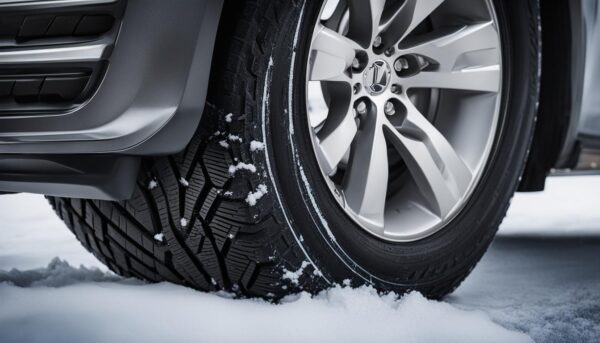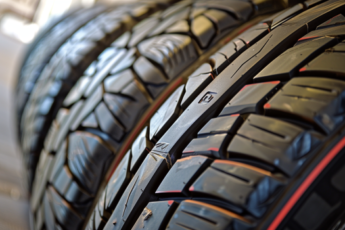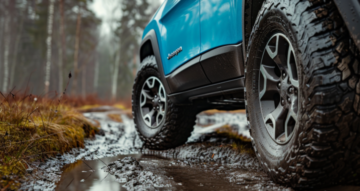Last Updated on 7 days
Choosing Between Winter Tires and All-Season Tires
Making the right tire choice is crucial for driving safety in various weather conditions. As you ponder between winter tires and all-season tires, several factors come into play, including your geographical location and the type of winter conditions you typically encounter. Winter tires are engineered to handle actual winter conditions, such as heavy snowfall and black ice. In contrast,e all-season tires are designed for various conditions, including wet roads and light winter driving. All-season tires can manage some winter conditions due to their versatile performance, but when it comes to harsh winter environments, winter tires are essential for maintaining traction.
Think of all-season tires as the tennis shoes of the tire world – they’re serviceable but not optimized for all situations. In this article, we’ll explore the differences between winter and all-season tires, including their respective benefits, limitations, and the tire technology that impacts their performance on the road.
Key Takeaways
- Winter tires are specifically designed for harsh winter conditions, offering superior traction on snow and ice.
- All-season tires balance performance and convenience for drivers in moderate climates, capable of handling various driving conditions throughout the year.
- Tire technology, including rubber compounds, tread depths, and tread patterns, significantly influences tire performance in different weather conditions.
- Geographical location is pivotal in determining whether winter or all-season tires are the most appropriate for your driving needs.
- Investing in dedicated winter and all-season tires can offer long-term economic and safety benefits.
- Continued advancements in tire technology, such as winter-biased all-season tires, offer new options for drivers seeking the best tire for their specific circumstances.
- Ensuring driving safety remains the primary consideration when selecting the right tire type and regularly inspecting tire condition.
Understanding the Tire Technology: How It Impacts Your Drive
A tire’s performance is inherently linked to the rubber compounds it is constructed from. All-season tires use rubber designed to provide year-round performance in moderate climates without frequent extreme cold, ice, and snow. In contrast, winter tires incorporate unique tread rubber compounds that remain flexible in cold temperatures to maintain adequate traction. The rubber in all-season tires stiffens during extreme cold, leading to decreased traction, similar to the limitations of hard-soled shoes on icy surfaces.
The Role of Rubber Compounds in Tire Performance
All-season tires feature rubber compounds designed for versatile performance, balancing the softness required for ideal traction in warmer weather and the hardness necessary for durability in colder conditions. On the other hand, winter tire benefits stem from their use of specialized rubber compounds that remain flexible in frigid temperatures, allowing them to maintain superior traction and grip on icy and snow-covered road surfaces.
The Importance of Tread Depth and Patterns for Winter Tires
Winter tires are defined by their unique tread depths and specific tread patterns, which maximize performance in winter conditions. The deeper tread depths prevent snow buildup, allowing for better grip when maneuvering through snow. In addition, the tread patterns are designed to efficiently channel away snow, slush, and water, improving overall winter traction.
“The deeper the tread, the better the snow traction. It helps provide ‘void’ for the snow that is packed into a tire’s treads to evacuate while moving through slush and snow.”
Biting Edges and Sipes: Enhancing Grip on Ice and Snow
Winter tires feature biting edges and a high density of sipes, greatly enhancing grip on icy surfaces. Biting edges refer to the numerous small protrusions or ridges created by the unique tire tread, while sipes are tiny slits within the track. These components act like thousands of small biting mechanisms that grip the road surface under snowy and icy conditions, crucial for maintaining control of the vehicle in winter.
- Biting edges: Small protrusions on tire treads that improve ice traction
- Sipes: Tiny slits within the track that create additional harsh edges to enhance grip
In conclusion, drivers must understand tire technology and how it influences a tire’s performance. All-season tires offer convenience and flexibility, while winter tires provide unmatched traction and control during harsh winters. With proper knowledge of rubber compounds, tread depth, and tread patterns, drivers can make informed decisions to maximize their safety and overall driving experience.
Winter Tire Features: Engineered for the Extremes
Winter tires are designed to optimize performance in harsh winter conditions, offering superior cold-temperature traction compared to other tire types. Their unique features, such as specialized rubber compounds and meticulously engineered treads, are crucial for maintaining control and safety on ice and packed snow.
Impact of Cold Temperatures on Winter Tire Traction
Cold temperatures directly influence the traction provided by winter tires. Conventional all-season tire compounds tend to stiffen in extreme cold, leading to diminished grip and performance. In contrast, winter tire compounds are engineered to maintain flexibility, even in frigid conditions. This enhanced flexibility allows the tire to conform to the road surface, dramatically improving traction and handling on slippery surfaces.
The Science Behind Snow Tire Tread Designs
Another critical aspect of winter tire performance is the tread design. Snow tire treads are crafted through rigorous research and engineering to optimize performance in challenging winter road conditions. Notable winter tire features include:
- Deep tread depths enable the tire to bite into snow, reducing snow buildup in the tread and maintaining grip.
- Unique tread patterns: These efficiently channel away snow, slush, and water, enhancing overall winter traction.
- Biting edges: The high density of sipes (tiny slits within the tread) provide numerous biting edges for added grip on ice and snow-packed surfaces.
One example of snow tire tread science is Bridgestone’s multi-cell compound found in their Blizzak line of winter tires. This advanced technology works like a sponge, removing thin layers of water from the ice’s surface and reducing the risk of slipping or hydroplaning.
| Winter Tire Feature | Function |
|---|---|
| Specialized Rubber Compounds | Remain flexible at frigid temperatures, enhancing traction on ice and snow. |
| Deep Tread Depths | Prevent snow buildup in the tread and provide better grip on snow-covered roads. |
| Unique Tread Patterns | Channel away snow, slush, and water, improving overall traction during winter months. |
| Biting Edges and Sipes | Increase grip on icy and snow-packed surfaces, providing enhanced control and safety. |
Investing in winter tires with these critical features is essential for ensuring optimal performance and safety on the road during the harshest winter conditions. By understanding the impact of cold temperatures on winter tire traction and the science behind snow tire tread designs, drivers can make informed decisions when selecting tires best suited for their driving needs.
All-Season Tire Benefits: A Balance for Varied Conditions
All-season tires have become famous for drivers who experience diverse weather conditions, particularly those in moderate climates. These tires offer several advantages, including a versatile performance, quiet rides, and good tread life, making them an appealing option for many drivers.
All-season tires are designed to handle various driving conditions, including dry and wet roads and light winter driving. This makes them convenient for drivers who do not want to switch tires throughout the year. Additionally, all-season tires provide a smooth, quiet ride, which adds to their appeal.
All-season tires offer a balance that caters to drivers living in moderate climates, providing versatility and reliable performance across different conditions including dry roads, wet roads, and light winter driving.
One of the most significant all-season tire benefits is their long tread life. They are designed to withstand weather conditions and offer longer-lasting performance than specialized summer or winter tires. This makes them a practical and cost-effective option for many drivers.
| All-Season Tire Benefits | Summer Tire Benefits | Winter Tire Benefits |
|---|---|---|
| Versatility in different weather conditions | Optimal performance in high temperatures | Superior grip on snow and ice |
| Longer tread life | Improved handling and cornering | Flexible even at low temperatures |
| Quiet and smooth ride | Effective on wet and dry roads | Enhanced braking and acceleration on slippery surfaces |
It is important to note that while all-season tires provide numerous benefits for moderate-climate driving, they may not be the ideal choice for all drivers. A dedicated set of winter tires may better serve those frequently encountering harsh winter conditions. But for many, the versatile tire performance of all-season tires meets their driving needs throughout the year and offers the convenience and utility they desire.
Winter Tire Performance: Mastering Snow and Ice
Winter tires are specifically engineered for winter tire mastery over snow and ice conditions, equipping drivers to handle heavy snowfall and black ice episodes. They boast specialized tread rubber, intricate tread patterns, and biting edges, which contribute to improved braking, handling, and overall safety during the most unpredictable winter road conditions.
The mastery of snow performance and ice handling can be attributed to various unique features of winter tires.
- Specialized Tread Rubber
- Intricate Tread Patterns
- Biting Edges
“Winter tires are specifically designed for mastery over snow and ice conditions, equipped with features that ensure optimal performance during heavy snowfall and black ice episodes.”
Let’s explore these key features that make winter tires the unrivaled choice for conquering snow and ice:
Specialized Tread Rubber
Winter tires utilize unique rubber compounds that remain flexible in cold temperatures, allowing them to maintain traction even in the most chilling conditions. In contrast, all-season tires tend to stiffen in extreme cold, leading to decreased traction and more incredible difficulty handling icy surfaces.
Intricate Tread Patterns
Winter tires feature unique tread patterns designed to improve snow and ice performance. These tread patterns help to channel away snow, slush, and water, making it easier for the tire to maintain contact with the road and provide better grip during hazardous driving conditions.
Biting Edges
Another crucial aspect of winter tires is their abundance of biting edges and sipes, which are tiny slits within the tread. These elements act like thousands of small biting mechanisms, gripping the road surface under snowy and icy conditions and providing drivers with superior control and stability.
In summary, winter tires are expertly engineered to tackle the most adverse winter road conditions, providing drivers with greater confidence, control, and safety when navigating snowy and icy terrain.
The Compromises of All-Season Tires in Severe Weather
While all-season tires can handle mild weather conditions, their performance in extreme winter environments can often be compromised. This happens because all-season tires are designed to balance summer and winter performance, making them a versatile choice for drivers who encounter diverse weather conditions throughout the year. However, this versatility also leads to limitations, particularly when it comes to severe winter driving.
How All-Season Tires Manage Mild Winter Challenges
All-season tires have features that allow them to manage mild winter challenges, such as light snow and wet, slushy roads. They typically offer adequate grip and can maintain a relatively smooth and quiet ride even in these conditions. Nevertheless, all-season tires show their limitations when it comes to heavy snowfall, ice, and extreme cold.
All-season tires can be compared to tennis shoes – versatile footwear that can be worn in various conditions, but not specifically optimized for certain adverse situations, such as ice or heavy snow.
The performance of all-season tires diminishes significantly in extreme winter conditions due to the stiffening of their rubber compounds, which results in decreased traction and handling capabilities. They are thus less suited for areas prone to heavy snowfall, prolonged periods of ice and cold, and frequent temperature fluctuations.
- Inability to perform optimally on heavy snow and ice-covered roads
- Decreased traction and handling as the temperature drops
- Less effective braking on icy and slippery surfaces
| All-Season Tires | Winter Tires |
|---|---|
| Designed for versatile performance in various conditions | Designed specifically for optimal winter performance |
| Can handle light snow and wet roads | Can handle heavy snow, ice, and extreme cold temperatures |
| Rubber compounds stiffen in extreme cold, reducing traction | Rubber compounds remain flexible in extreme cold for consistent traction |
| Decreased braking performance on icy surfaces | Enhanced braking performance on icy and snow-covered surfaces |
In conclusion, all-season tire limitations should be considered when evaluating their suitability for severe winter weather conditions. Drivers who frequently encounter harsh winter conditions may need to consider investing in a separate set of winter tires to ensure optimal safety and performance on the road.
The Verdict on All-Season Tire Traction in Winter

The individual’s driving environment largely determines whether all-season tires are used during winter. All-season tires may suffice for those who rarely experience more than light snow flurries and icy roads occasionally. But for those facing consistent periods of icy roads, winter tires are not merely a precaution but an essential for ensuring safety and maintaining traction throughout winter conditions.
It is recommended to use winter tires for their superior grip and the significant safety measures they provide in treacherous driving situations. To better understand the suitability of all-season tires in winter, it is essential to compare the critical performance aspects of winter and all-season tires. The table below highlights the differences in their performance:
| Performance Aspect | All-Season Tires | Winter Tires |
|---|---|---|
| Traction on Snow and Ice | Adequate for mild conditions | Superior grip and control |
| Flexibility in Cold Temperatures | Less flexible, reduced traction | Flexible, maintaining traction |
| Tread Pattern and Depth | Designed for diverse conditions | Optimized for snow and slush |
| Braking Distance | Longer on icy surfaces | Shorter, ensuring better control |
In conclusion, the choice of all-season tire traction versus winter tires for winter driving safety depends on the specific conditions each driver encounters. By examining the tire performance verdict, drivers can decide whether all-season tires will provide adequate protection and performance for their winter driving needs.
How Geography Influences the Winter Tires vs All-Season Debate
Geographical location plays a pivotal role in the debate of winter tires versus all-season tires. The decision is heavily influenced by climate and local weather patterns, requiring drivers to assess their locale’s typical weather conditions, such as regular temperature ranges, snowfall frequency, and the incidence of ice on the roads. Securing the appropriate tires to match these factors is crucial for safer driving.
Examining Climate and Weather Patterns for Tire Selection
To make a climate-based tire selection, it’s essential to understand the weather pattern considerations for each region. Drivers can analyze historical climate data and consider factors like average temperature fluctuations, the extent of seasonal changes, precipitation levels, and the likelihood of frost or icy conditions.
“Choosing the right tires based on your region’s climate and weather patterns can have a significant impact on driving safety and tire lifespan.”
Let’s examine the tire needs for three different climate scenarios:
- Mild Winters: All-season tires may be sufficient for safe driving conditions in regions with mild winters and minimal snow and ice.
- Harsh Winters: For areas experiencing heavy snowfall, freezing temperatures, and frequent ice buildup, winter tires become necessary to maintain traction and control during slippery conditions.
- Mixed Climates: In locales with diverse climate conditions, where winters are unpredictable and can vary between mild and severe, it may be beneficial to invest in all-season and winter tires, switching them out as the seasons change.
By understanding the influence of geography, drivers can make informed decisions about which tire type best suits their needs and ultimately prioritize safety and optimal performance.
| Climate | All-Season Tires | Winter Tires |
|---|---|---|
| Mild Winters | Suitable | Not Necessary |
| Harsh Winters | Not Advisable | Highly Recommended |
| Mixed Climates | Recommended for Non-Winter Months | Recommended for Winter Months |
In conclusion, geography and local climate conditions are crucial factors in determining a driver’s most suitable tire choice. By carefully considering one’s driving environment and regional weather patterns, the most appropriate tires can be selected, resulting in safer and more efficient driving experiences.
Snow Tires vs. All-Season Tires:
Safety and EconomicsFinancial considerations are often a significant factor when deciding between snow and all-season tires. This section will explore the cost considerations in choosing between these tire types and the long-term investment in purchasing seasonal tires.
Cost Considerations in Choosing Between Tire Types
Investing in a dedicated set of winter tires can lead to additional expenses, including potential storage costs for the off-season set and the labor necessary for seasonal tire changes. Despite these added expenses, the investment ensures optimal driving safety in harsh winter conditions, potentially saving lives and preventing accidents. An overview of the costs involved in both tire types is provided in the table below:
| Tire Type | Initial Purchase Cost | Storage Costs | Seasonal Change Costs (Per Change) | Total Estimated Cost (for four years) |
|---|---|---|---|---|
| Snow Tires | $500 – $800 | $60 – $120 (per year) | $50 – $100 | $1,240 – $2,280 |
| All-Season Tires | $400 – $700 | N/A | N/A | $400 – $700 |
The Long-Term Investment in Seasonal Tires
Investing in seasonal tires can be economically advantageous from a long-term financial standpoint. Owning all-season and winter tires may lead to extended tire life for both sets, as each is used only for part of the year. This reduces wear and tear associated with year-round use of a single location, yielding cost savings. In addition, a proper tire selection that prioritizes safety could help avoid accidents, reducing potential unexpected costs.
In conclusion, drivers must weigh the snow tires and all-season tire economics alongside their specific driving needs and geographical location to make an informed decision. The additional investment in winter tires may be worthwhile for those living in areas with harsh winters, while all-season tires may suffice for drivers in milder climates.
Advancements in Winter Tire Technology: Bridgestone Blizzak and Beyond

Over the years, winter tire advancements have been instrumental in revolutionizing the performance of vehicles in snowy and icy conditions. Among these innovations, Bridgestone’s Blizzak technology stands out as a prominent example, showcasing the modern strides made in manufacturing contemporary snow tires.
The patented multi-cell compound featured in Bridgestone Blizzak tires is designed to absorb water from icy surfaces, significantly increasing ice traction. This technological breakthrough gives drivers better vehicle control and enhances safety while driving on treacherous winter roads.
Contemporary tire technology comprises numerous advancements, improving safety and performance under harsh winter driving conditions. Some of these advancements include:
- It has advanced rubber compounds that remain flexible at low temperatures, providing superior grip in cold weather conditions.
- It enhanced tread patterns that promote efficient channeling of water, slush, and snow, resulting in more excellent winter traction.
- Using intricate sipes and biting edges facilitates improved ice traction and handling.
These innovations set a high bar for the future development of winter tires. As research and development progress, tire manufacturers strive to employ cutting-edge technologies for safer, more reliable, and more efficient winter driving solutions.
“The goal of tire manufacturers is not only to meet the industry’s safety regulations, but also to create tires that save lives, by offering the best possible performance in the most extreme conditions.”
As we move forward, the tire industry will likely witness multiple breakthroughs in winter tire technologies, offering consumers even better performance and reliability.
Making an Informed Decision on Tire Types for Your Driving Needs
When picking the right tire type, making an informed decision is crucial to ensure safety, performance, and convenience. To conduct a proper driving needs analysis, it’s essential to consider the following factors: The severity of winter weather.
- Temperature stability
- Personal driving patterns
By understanding your unique driving needs and assessing your climate’s characteristics, you will be better equipped to choose the perfect tire type that supports your lifestyle and optimizes your vehicle’s performance.
In addition to considering these factors, you can also evaluate the key differences between various tire types:
| Winter Tires | All-Season Tires | |
|---|---|---|
| Best for | Severe winter conditions | Moderate climates |
| Rubber Compound | Flexible in cold temperatures | Designed for year-round performance |
| Tread Design | Optimized for ice and snow traction | Versatile for various road conditions |
Ultimately, the right tire type for your driving needs would depend on the prevailing weather conditions in your region and your own driving habits.
Remember, there is no one-size-fits-all answer when selecting the perfect tire type. The best choice will consider your circumstances, driving conditions, and habits. With a well-informed decision based on careful analysis, you will be better prepared to tackle the road ahead and ensure your driving experience is safe, comfortable, and optimized for performance.
Winter-Biased All-Season Tires: A New Option for Drivers
Amid rapid tire innovations, winter-biased all-season tires have emerged as an appealing solution for drivers seeking a balance between year-round durability and enhanced performance on snow and ice compared to traditional all-season tires. Although not attaining the peak performance of pure winter tires, these tires offer a compromise for individuals seeking a more cost-effective and practical solution than maintaining two sets of tires.
Winter-biased all-season tires are designed to provide slightly better performance on snow and ice while maintaining durability for year-round usage.
With several options available in the market, the following table provides an overview of some popular winter-biased all-season tire models:
| Brand | Model | Targeted Climate | Key Features |
|---|---|---|---|
| Michelin | CrossClimate+ | Areas with unpredictable and dynamic weather conditions | Unique 3D siping designed for improved grip in snow and ice, high-quality rubber compound for durability |
| Goodyear | Assurance WeatherReady | Regions experiencing wet and snowy conditions | Weather Reactive Technology for improving traction in wet, snowy, and icy conditions, asymmetric tread pattern for improved control in corners |
| Pirelli | Cinturato P7 All-Season Plus | Drivers in moderate climates with occasional snowfall | Optimized tread design for increased comfort and reduced noise, optimized mold profile for even wear, and extended tread life |
As the need for driver options grows, selecting the appropriate tire type becomes increasingly crucial. Winter-biased all-season tires represent a promising and practical choice for drivers navigating dynamically changing weather conditions and seeking more cost-effective solutions. In making an informed tire decision, it is essential to consider the climate and driving conditions specific to your lifestyle and geographical location.
Conclusion
The tire selection decision is a highly individualized process based on various factors such as climate, geography, and driver needs. Both winter and all-season tires have their respective advantages and are designed for specific conditions in which they excel. Tire technology continues to advance, with options like winter-biased all-season tires adding depth to the choices available for drivers.
Ultimately, driving safety should be the primary consideration when determining the most suitable tires for one’s vehicle throughout the year. Regular tire inspections and replacements are critical components of maintaining vehicular safety on the road, irrespective of the tire type chosen.
In conclusion, the debate between winter and all-season tires can be better navigated by analyzing your unique driving environment and conditions. By focusing on what factors define your driving circumstances, you can make an informed decision that prioritizes safety and optimizes performance in all weather conditions.
FAQ
What is the critical difference between winter and all-season tires?
With specialized tread designs and rubber compounds, winter tires are designed to handle harsh winter conditions, such as heavy snow and ice. All-season tires offer versatile performance for various conditions, including wet roads and light snow, but are not optimized for heavy snow and extreme cold temperatures.
Do I need winter tires if I have all-season tires?
It depends on your geographical location and the winter conditions you regularly encounter. If you consistently face heavy snowfalls and icy roads, investing in winter tires is recommended for optimal traction and safety during winter months. All-season tires may suffice if you only occasionally experience light snow and icy conditions.
How does tire technology affect driving safety and performance?
Tire technology, such as rubber compounds and tread designs, plays a crucial role in a vehicle’s performance, traction, and overall safety. The rubber compound used in winter tires remains flexible in cold temperatures, enhancing grip on ice and snow. Tread designs help maintain traction and channel snow, slush, and water away from the tire.
What are some winter tire features that improve performance in cold conditions?
Features such as unique tread rubber compounds, deeper tread depths, and biting edges increase winter tire performance in cold conditions. These elements ensure winter tires remain flexible and maintain traction on icy and snowy surfaces while expelling water and slush efficiently.
Are there any new tire innovations for handling a mix of winter conditions?
Winter-biased all-season tires are a recent innovation that offers slightly better performance on snow and ice than traditional all-season tires while maintaining durability for year-round usage. They provide a practical alternative for drivers who cannot manage the costs and practicalities of maintaining two tire sets but still require some extra traction during winter.
How do I decide if I need winter or all-season tires for my vehicle?
Choosing the correct type of tire depends on factors such as your geographical location, weather conditions, and personal driving habits. By assessing local climate, temperature stability, and winter conditions, you can decide on the best tire type to ensure safety and performance for your driving needs.










